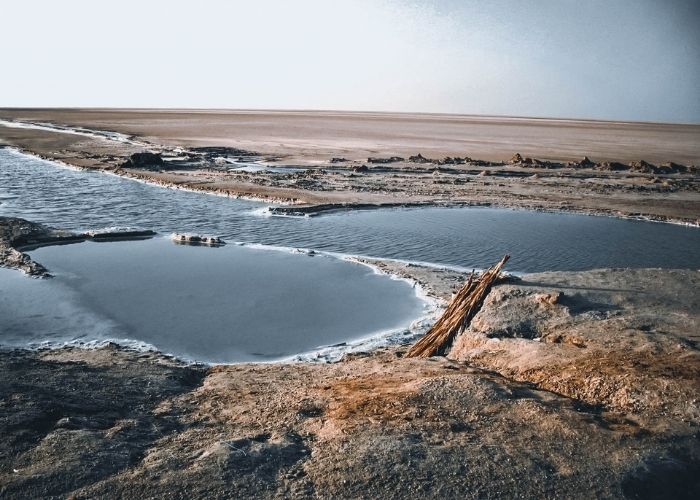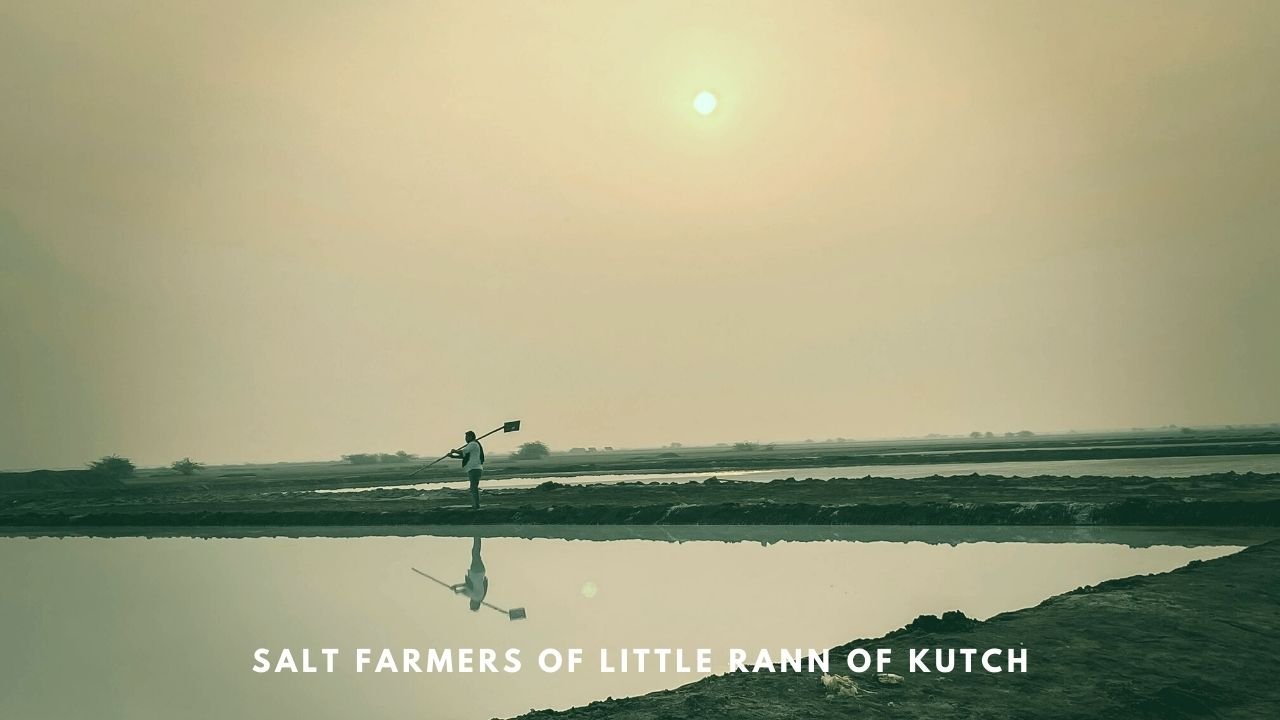It was a cold morning in December when we went for a wildlife safari in the LRK Wild Ass Sanctuary. Having seen the flamingos as well as the wild ass, I had literally thought that it was a morning well spent. And then our jeep stopped before a small shack in the middle of literally nowhere. Oh! We had come to visit the salt farmers of Little Rann of Kutch.
The topography of Little Rann of Kutch is such that it provides sanctuary to a host of wildlife including migratory birds. But this place is also the home of the Agariyas, or the traditional salt farmers of Gujarat.

Yes, it is the same salt that we use in our food to make it tastier. Infact, almost 75% of India’s total salt production. So, who are these people who bring the salt to our plates? What do they actually do? And what had Rann of Kutch, mostly known for the famous Rann Utsav, had to do with it? Read on to know more about the place and the salt farmers of Kutch.
Rann of Kutch

Located about 130 km from Ahmedabad, Rann of Kutch is the seasonal salt desert of India. The terrain is harsh, but the landscape is surreal. As you look across the white desert, it seems that the horizon is meeting the endless sea. Only there are no waves and water!
These saline mudflats located in Kutch district of Gujarat and stretching across the borders of Pakistan are known as the Rann of Kutch. This tortoise-shaped land is divided into the Great Rann covering an area of 18000 sq km and the Little Rann covering 5000 sq km.
Topography of Rann
The topography and landscape of the Rann is unique. The white desert that stretches across miles does not remain like this for the entire season. During the monsoons, especially from the end of June, rains flood the entire region and the Rann is submerged under water, practically becoming a wetland. Water flows in from the 11 rivers of Saurashtra, North Gujarat and Rajasthan and the marine waters from the Gulf of Kutch turns Little Rann of Kutch into a brackish lake.

Come October, the water starts evaporating leaving behind a cracked terrain that is rich in salts and minerals. For eight months, this area remains a desert. This is the time when the salt farmers or the Agariyas migrate from the villages in the surrounding district to Little ran of Kutch. It is the time when these salt deserts become their workplace.
Geological Origins
The geological origins of Rann of Kutch is said to have begun more than 200 million years ago in pre-Jurassic and Jurassic periods. Even until several hundred years ago, the desert that we see today was actually part of the sea. It was a navigable sea route from the Gulf of Kutch flowing upstream to the Indus valley! Infact, this area was believed to be a part of the Indus Valley civilization, one of the earliest civilizations in the world. And I am talking about a time between approximately 3330 BC to 1300 BC.
However, a couple of centuries ago, a massive earthquake changed the topography of the region. The jolts from the earthquake caused the landscape to rise while creating a series of depressions that was filled up with sea water. Land formations were changed and this once navigable sea route was closed off from the Arabian Sea. These geological events essentially trapped sea water beneath the land and made Rann what it is today.

Salt Farmers of Kutch
Salt farming started a long way back in the Kutch region. Some believe that it was almost 2 centuries ago when a local community noticed that the water below the ground level was brine (concentrated salt solution). And they could extract salt from these waters. And thus, the business of salt farming began in Kutch. The salt farmers are known as Agariyas (Agar means salt farm).

Salt farming has thus become a huge industry in the Rann. A number of workers from surrounding villages venture in this monsoon-soaked desert land in October. As the water recedes in October and November, the workers start the harvesting process. Braving the extreme temperatures of the barren desert and the harsh conditions, the Agariyas spend almost 8 months harvesting salt. The entire family including women and children work to harvest salt. The women especially are the main workers.
There are nearly 6 concentrated salt zones in Little Rann of Kutch – Dhrangadhra, Kharaghoda, Halvad, Santalpur, Adesar and Malia.
How is Salt produced?
The Agariyas extract the brine from underground reserves to produce salt. Work starts just after the monsoon. The Agariyas take their possessions in camel carts and migrate to Little Rann of Kutch to lay out the salt pans.

Usually, a pump is used to bring out the brine from underground and is collected in huge square-shaped salt pans. Here, the process of natural evaporation begins. The brine needs to be concentrated more for harvesting. So, the brine passes through one salt pan to the next a number of times.
Getting these pans ready is also a tedious process. The farmers stamp and level the earth by their bare feet so that the bed is hard and impervious and there is a slope for the brine to flow. Otherwise, the brine can seep back into the soil.
The salt farmers, in the meantime, live in the makeshift shanties in the same area.

Once the first layer of salt is formed, it is scraped with heavy wooden rakes. The salt farmers continue the raking and scraping till the salt crystal reaches a thickness of seven to nine inches. Smaller crystals fetch higher prices. The salt is mostly harvested by hand. Locally, this salt is known as Badagara (Bada means big and Agara means salt pan. The scraped salt is then kept on the sides of the pan. Later, the salt is collected and taken by trucks to the periphery of Little Rann of Kutch. From there, it is taken to the markets.

Every 15 days an average of 12 to 15 tonnes of salt is collected and sent to the factories across the country.
Each salt pan can produce an amount of 400 tonnes of salt and a family of 4-5 can produce an average of 800 tonnes of salt per season.
Harvest season ends in June, just before the monsoon approaches.
Working Conditions of the Salt Farmers
The working conditions of Agariyas are harsh. The summer temperature can go up to 50 degree Celsius in the day. And often the night temperature dips down to 6-7 degrees.
And then there is the problem of drinking water. A family receives about 1000 litres of water for 15 days. This amount is just enough for drinking and cooking purposes. Sometimes they have to walk almost 8 kilometers to get drinking water or even for a bath. So sanitation and hygiene always remains a concern for them.

And finally, the hard work in such harsh conditions takes a toll on the health of the Agariyas. Their feet are almost always exposed to the highly saturated brine in the salt pans and become stiff and thin from standing the salt pans for such a long time. Their hands too become stiff and often water oozes out from their legs. It is said that their legs become so stiff that after their death, the legs do not burn in the funeral pyre and have to be buried separately.
The direct rays of sun as well as the salt also causes skin and eye problems. Thus, the life of Agariyas is quite tough.
The average life of a salt farmer of Kutch is only 60 years.
However, these days, the government and a few NGOs have started distributing gumboots, caps and safety kits for the salt farmers. Mobile health vans and drinking water are also made available to them.

Money is not Good
And then, the Agariyas do not get much for such hard work. They get a measly amount of 20 to 30 paise per kilogram for the salt produced. The cost depends on the quality of the salt and market demand.
And how much do we pay for a kg of salt? It is around Rs 20. I do agree that the salt we consume has to be processed and packed. But even then, don’t you think that the salt farmers get a raw deal out of it?
The low price for their trade has a few repercussions as well. Due to poverty, often the children are not sent to school and they start working at the salt pans from the age of 10 years!

We met one of the Agariyas at Little Rann of Kutch. He and his wife were the only one at their shanty at that time. He explained to us the process of salt harvesting and also told us about the hardships faced by them.
The sun was already bright in the sky and we were ready to leave Little Rann of Kutch. The safari was great, we had an amazing experience at Rann Utsav and the days ahead looked even greater. However, I left the place with a poignant feel, thinking about the community who works so hard, yet gets so little.
It seems while salt is an essential commodity, salt makers are not important.








0 Comments